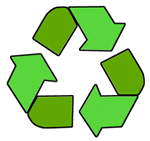TruePulse Environmental Policy
As we enter this millennium, there is a growing consensus that individuals and corporations must help to protect our environment.  It is everyone’s responsibility to live in a way that provides long-term sustainability for our planet. At TruePulse we believe that the best way for people to assist in this goal is through the simple strategy to “recycle – reduce – reuse”.
It is everyone’s responsibility to live in a way that provides long-term sustainability for our planet. At TruePulse we believe that the best way for people to assist in this goal is through the simple strategy to “recycle – reduce – reuse”.
At TruePulse, our mission is to help Telecommunication Service Providers meet their environmental responsibilities. Service providers regularly decommission equipment from their network. Much of this equipment is currently scrapped. However, another service provider may find that same equipment to be valuable in their network. Our role is to facilitate the transfer of useful equipment (the re-use part of the environmental mantra) from one service provider to another. The seller of the equipment makes money on his decommissioned equipment, the buyer saves money compared to buying new, and TruePulse makes a small profit. We are showing all businesses a strong example that being environmentally responsible can be good business too!
At TruePulse we are totally committed to “recycle – reduce – reuse”. One of our objectives is to re-use boxes and packaging materials when possible, and to recycle when they are not. We believe that our customers appreciate the extra effort (and cost) involved with reusing these materials.
We attempt to have defective cards repaired to the extent that this is economically feasible. In the event that this is not, we provide the cards to a recycler who removes as much valuable materials from the cards as is possible.
Telecommunication Service Providers re-use equipment from others and save money. They win! Less equipment goes off to landfill sites. The environment wins!
One of the more effective initiatives to reduce the use of hazardous materials on telecommunication circuit boards is The Restriction of Hazardous Substances Directive 2002/95/EC (RoHS 1). Short for directive on the Restriction of the use of certain Hazardous Substances in electrical and electronic equipment, it was adopted in February 2003 by the European Union. The RoHS 1 directive took effect on 1 July 2006, and is required to be enforced and became a law in each member state. This directive restricts the use of ten hazardous materials in the manufacture of various types of electronic and electrical equipment. The substances banned under RoHS are lead (Pb), mercury (Hg), cadmium (Cd), hexavalent chromium (CrVI), polybrominated biphenyls (PBB), polybrominated diphenyl ethers (PBDE), and four different phthalates (DEHP, BBP, BBP, DIBP). Most circuit boards manufactured today are RoHS compliant. If that is a requirement for you, please ask for clarification before purchase. More information on RoHS.
Other environmental web sites of interest:
Evergreen (revitalizes school grounds and public parks)
Energy Efficient Office
Composting Lawn Waste and Lawns
Water Efficiency Program
Canadian Environmental Assessment Agency
Ontario’s Drive Clean Program
Environmental Commissioner of Ontario
Goodwill (takes donations and resells used clothes and home items)
Reboot Canada (collects used computers for schools and charities)
David Suzuki Foundation
Updated August 11, 2020
